It’s one of the biggest drawbacks of content marketing…
How are you supposed to find time to create high-quality content?
On top of all the other things you need to do, now you must find the time to create epic posts.
These types of posts often take several hours to create. If you’re a small business owner, you have many other things on your plate demanding your attention: customer service, product creation and improvement, social media, and other forms of marketing.
And if you’re a marketer of any kind, you’re being asked to create more and more content. 45% of B2B marketers reported that they are creating more content this year (compared to last year).
We’ll tell you something for sure:
Most of those marketers don’t even produce epic content. And yet, they’re spending even more time on it. Why? Because it’s still working for them.
Over time, their results will diminish, and they will decide to either give up or up their content game.
We hope you’re ahead of the curve and are already creating next-level content. But that leaves you with the time and resources issues. It’s hard to continually devote 20+ hours a week to creating content.
But there are a few ways to lessen the extent of this problem.
First, you can write more efficiently.
But you can also be more selective about which types of content you create. Some types of content take a few hours to put together, while others can take hundreds of hours.
One of the most effective types of content (when you look at results vs time to create) is curated content.
The basic idea is to take some (or all) of content created by someone else and feature it along with other related content. (Of course, you always provide credit.)
Even something as simple as a link to a guide in a post for more information could be considered curated content.
You’re finding content that you know your readers will be interested in and then connecting them to it.
Almost all content marketers curate content in one way or another. One report found that 82% of marketers curate content. Overall, the best marketers create around 65% of their own content and curate an additional 10%.
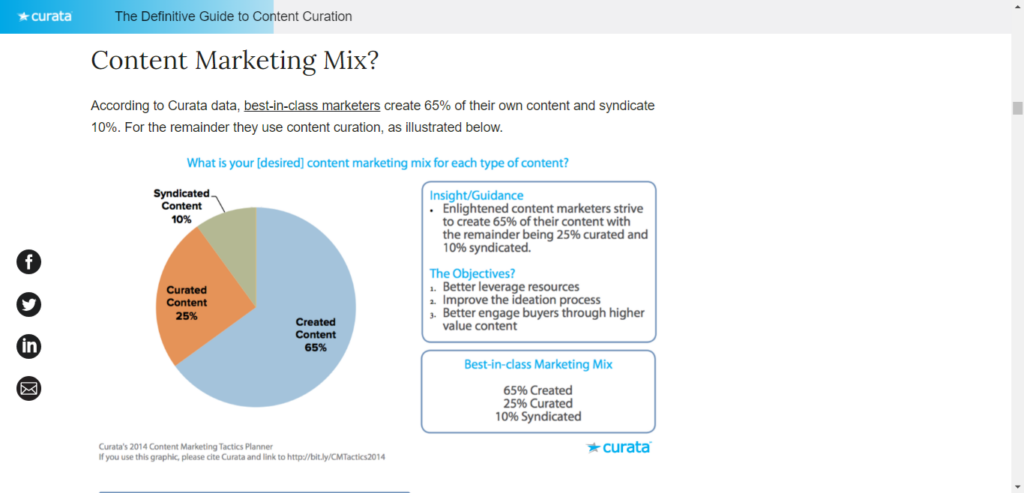
One of the most common ways to use curated content is for social media marketing. You typically need to share content other than your own to be successful, so finding the best content for your readers (that you didn’t make) is a key part of the process.
Curated content can be used in almost any niche, which is part of the reason why it’s so powerful.
However, not all businesses are successful at curating content.
If you do it incorrectly, your readers won’t pay much attention to what you offer, and you won’t get the results you’re after.
Luckily, we can show you how to do content curation right.
By the end of this post, you’ll know which types of curated content you should create and how to create them to maximize your results regarding traffic, shares, and subscribers.
4 Reasons you should publish more curated content
We’ve touched on a few positive aspects of curated content, but we want you to understand how it can help you.
Incorporating curation into your content strategy benefits you in four main ways.
Reason #1 – It’s faster and cheaper to create: Curated content is much faster to create than original content.
A great example of a curated article if HubSpot:
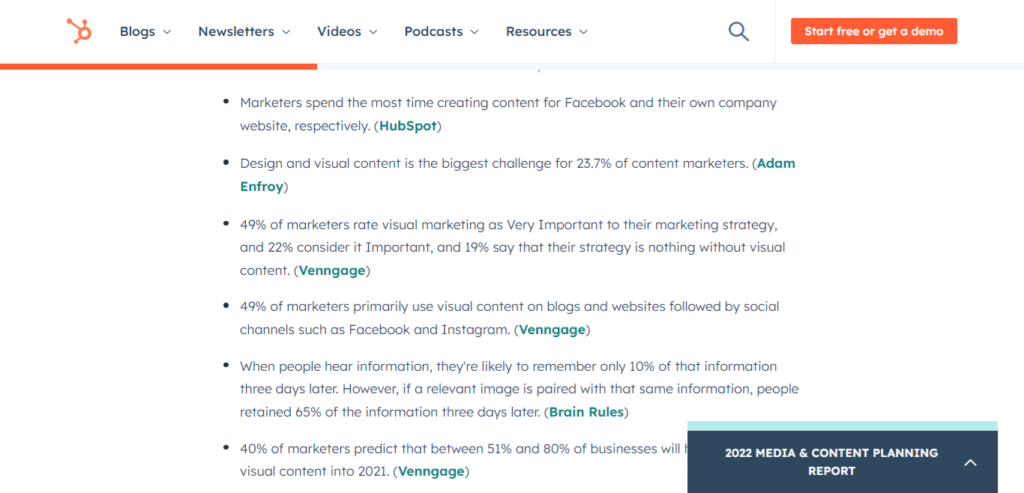
In total, there are 50 great resources on visual content strategies, but with an interesting twist:
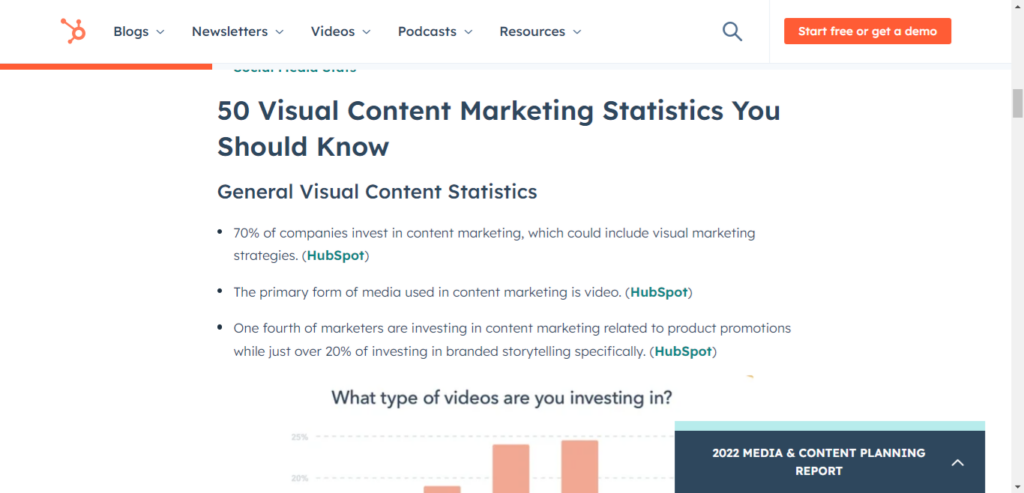
HubSpot is striking a balance between giving its audience an excellent curated resource list. Also, they’re using the opportunity to increase traffic to their other content.
A massive win-win.
How much time do you think it took him to put this together?
Our guess would be under five hours.
On top of that, there’s one other cool way in which content curation saves you time.
Most businesses and solopreneurs share content others have created on social media — it’s a reciprocal method of validating content from people you’d like in your network.
Well, guess what? Since you’ve researched all the best content to include in your curated content, you can share these resources on social media and save yourself a ton of time.
Reason #2 – Great results that you can continue to leverage after a content update:
Logically, it makes sense to assume that there’s a tradeoff.
With your own content, you get more traffic, engagement, etc., than you do with curated content, right?
It’s true that you probably won’t achieve the same results with curated content as you will with your own, but you don’t lose that much, either.
Case in point: Let’s look at Brian Dean’s link-building guide. There’s another intriguing update regarding this content that we’ll cover.
As of today, his combined Facebook and Twitter share is 6,586. in 2015, it was 1,180 — that’s a steady upward trajectory of engagement.
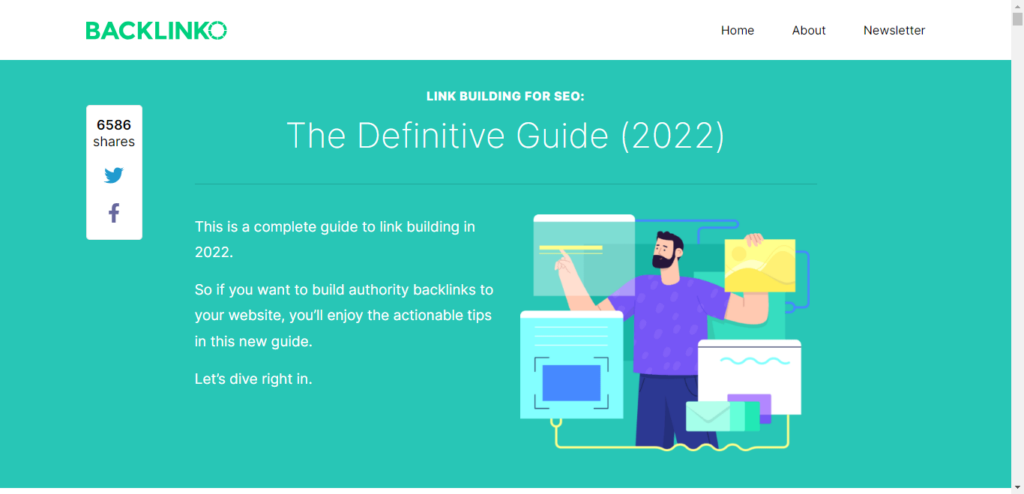
Over the years, content marketers will update their popular publications.
Today, this link-building guide has evolved beyond curated content.
But here’s the neat part — he retains the fruits of his engagement and authority labor from the curated content. Google won’t downgrade or penalize this because they actively encourage better content and user experience — read more about EATT here.
That’s why 48% of surveyed marketers said that curated content helped improve their brand visibility, SEO, traffic, and buyer engagement.
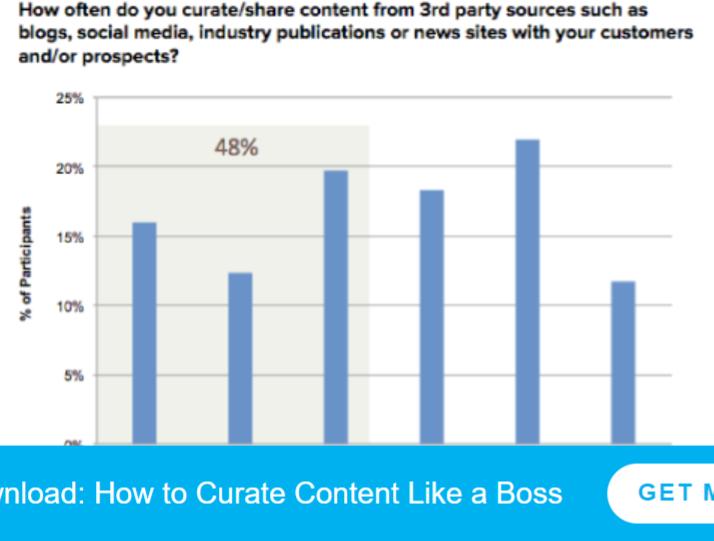
Reason #3 – You can expand out of your area of expertise:
Even after over 10 years, we still write on the same topics- mainly about social media, content marketing, and SEO.
But we know that some of our readers are interested in other topics as well, topics that we might not have much expertise in.
Here’s a quote from the same blog by Curata:
“Curated content from high quality third party sources helps you develop go-to web resources that improve your credibility and trustworthiness as an impartial authority on your topic.”
We could, of course, take extra time to research and experiment in those areas, but it can take months to become an expert.
Or we could curate the best content on those topics.
For example, we could create a guide to buying an online business with curated content. We don’t have much experience with it, so we couldn’t comfortably write about it right now, but we could curate it for our readers.
Reason #4 – You can use it to open relationships: One huge potential benefit of curating content is that it provides value to influencers — if you do it right.
A good piece of curated content will actually drive traffic to the sources you link to.
In addition, only including the best of the best increases the brand recognition and authority of the people or businesses you include.
People appreciate being featured, which gives you an in to develop a relationship with them.
If we curate a piece of content and decide to contact the content marketers we include, they’ll know exactly who we are. They may even reach out to thank us for including them — all credible opportunities to network.
Not to mention that reciprocal currency that can earn organic backlinks.
Think of it this way — one of the creators you boost through your curated article is preparing to upload their next authority content.
There’s a strong chance they’ll return the favor and link your content.
Step 1: 7 types of curated content you can publish
There’s one thing that you need to know about curated content:
No type fits all.
We mean that curated content can be used in almost any niche, but certain types work better for some than others.
Your first real challenge (step #1) is understanding the different types so that you can pick the best ones for you.
The best way we can teach you about each type is to show you an example, so let’s begin.
Type #1 – Ultimate guides on a topic: More written content is published online than any other type of content.
We’ve actually already looked at an example of an ultimate guide for visual content by HubSpot.
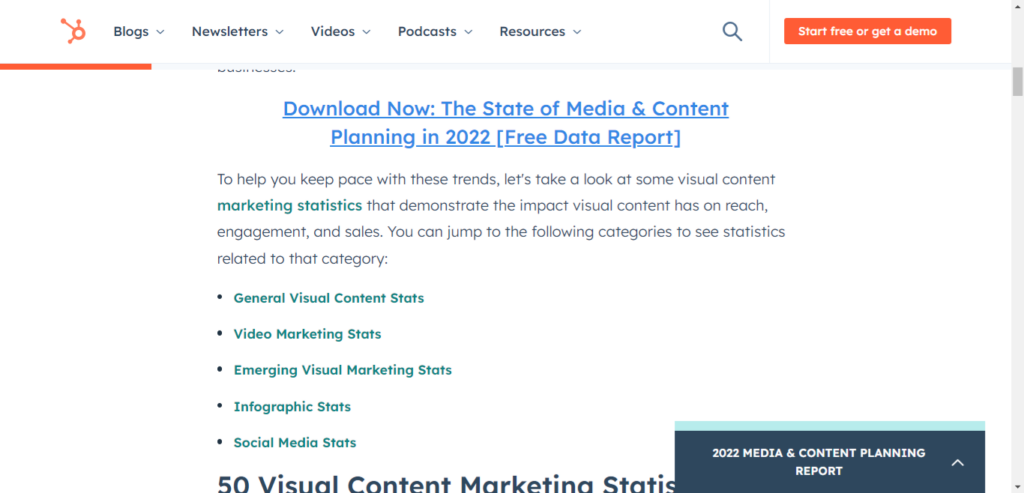
What’s the best use for it?
When you try to create a complete guide to anything, it will usually be about one of your main topics.
There’s no sense in creating a massive resource on a topic that only a small fraction of your target audience is interested in.
These types of guides are designed to wow readers and attract traffic, links, and social shares.
You should consider creating a curated ultimate guide when creating a complete guide from scratch isn’t practical.
Part of that is deciding the scope of your content (more on that later).
Since HubSpot wanted to cover such a huge topic, it would have taken him months to create all the original content.
His published curated guide probably took him less than a few weeks.
Who can use it?
Massive guides like this are best used in niches where audiences are willing to learn or, in this case, must learn to produce better content that drives traffic and engagement.
A bonus tip — did you notice the screenshot shows linked content?
HubSpot is not only including its own articles in this curated roundup (positioning itself with more authority), but they’re embedding links and reports.
Type #2 – Roundups: You’re probably familiar with at least one type of roundup, but we can look at a few different types of curated roundups.
First is the content roundup.
An example of one is The Moz Top 10 email newsletter that goes out semimonthly.
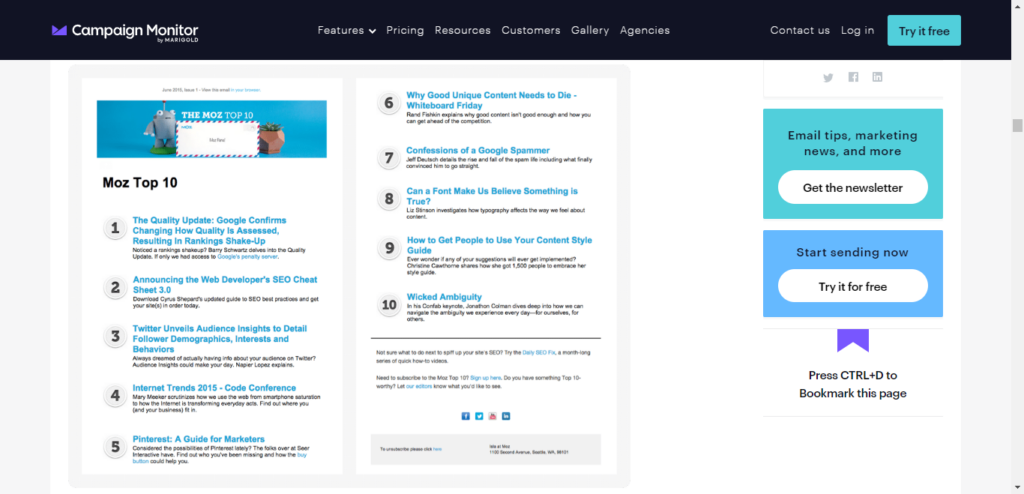
In Moz’s newsletter, the primary feature is the best 10 pieces of content for SEO.
Regular email roundups like these are best used in niches that move quickly. Changes are always happening in the SEO niche, which is why this works for Moz.
This type of roundup will work in any niche with at least one thriving niche news site.
Before we move on, the above image is from Campaign Monitor.
We’re not just noting that for attribution — there’s an intriguing aspect to this: this is a curated piece of content about curated content.
The second type of roundup is the expert roundup.
With this kind of roundup, you collect original answers from influencers and present them within one awesome post.
Typically, you’ll ask them all the same one or two questions, record all the answers, and then additionally add some insightful analysis of the results.
This type of roundup isn’t purely curation because you can also mix in your original content (or a contributor’s) content.
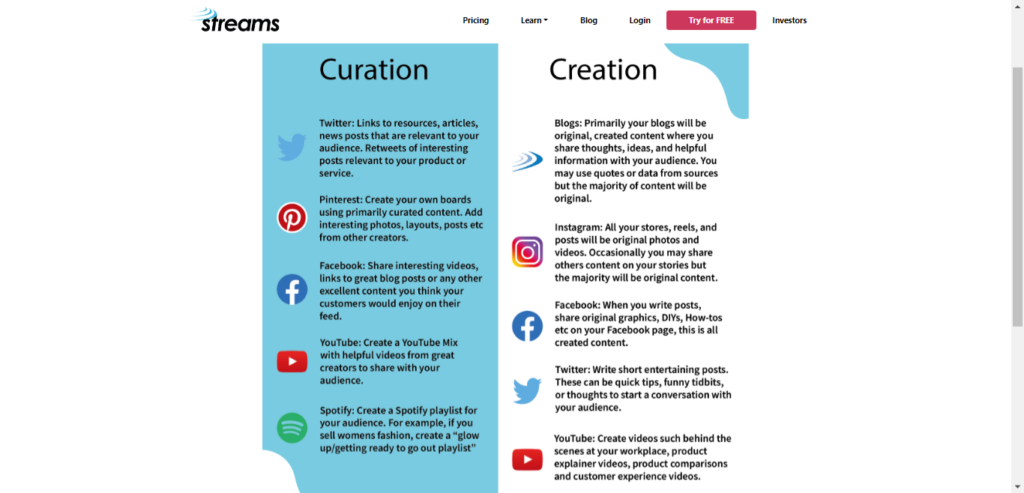
This brings up the most important takeaway: Don’t be afraid to mix original and curated content.
HubSpot did this to great effect in our previous example, and they’re not alone in this regard.
Often, you can add extra value to the curated content by presenting it within a certain context.
This type of roundup is best used in niches with tons of influencers, where the same questions are asked over and over again.
Usually, the questions are being asked repeatedly because they have subjective answers. This is where answers from experts (more is better) are given the most attention.
Type #3 – The best webinars: We wanted to quickly add webinar curation to this section. It lists the best webinars/video tutorials in your niche.
Webinars are getting extremely popular. However, they are also pretty long.
A curated list of the best webinars on a topic (available for replay) would get a lot of attention.
Type #4 – Case studies: In some niches, case studies are the most interesting type of content to readers.
Personally, we’ve seen how much readers appreciate seeing the results of case studies in the conversion rate optimization niche.
But running a complete test can take weeks, and then you’ll have to write the post as well.
Ultimately, readers are only interested in the idea behind the test, how you did it, and the results.
What if you could combine several case studies in a situation like this?
Showcase all the important information for each case study in a few hundred words.
If people love one case study, they’ll love having more in one place.
Here’s an example: A post with 100 conversion optimization case studies.
It would take years to run 100 good tests on your own. But by curating case studies that others have published (and only including the best ones), you create a really interesting and valuable resource.
Your audience can’t help but love it, and you could put it together in less than a week.
Where else can curated case studies be used?
Chances are you already know whether people appreciate case studies in your niche.
We’re actually a little surprised that no one has created a post like the one above for SEO case studies. People love to read about how website owners improved their traffic by X% over 6-12 months.
Here’s an example in the home design niche: the author compiled a list of 101 home remodeling projects (equivalent to case studies).
Notice we highlighted the shares — a staggering 267,700 of them!

Type #5 – Reading list/education list: Some niches are built around learning. As you’ve seen, some curated content already works great in these niches.
In these niches, people try to teach (and often sell) to anyone who listens.
This results in much content that no one has the time to read.
Of course, this is a perfect opportunity for curation. You can create something of tremendous value by simply going through the content and picking the best of it.
You’re saving your audience from reading the crap while also showing them the content they will love.
One example of this is Tim Ferriss’ book club:
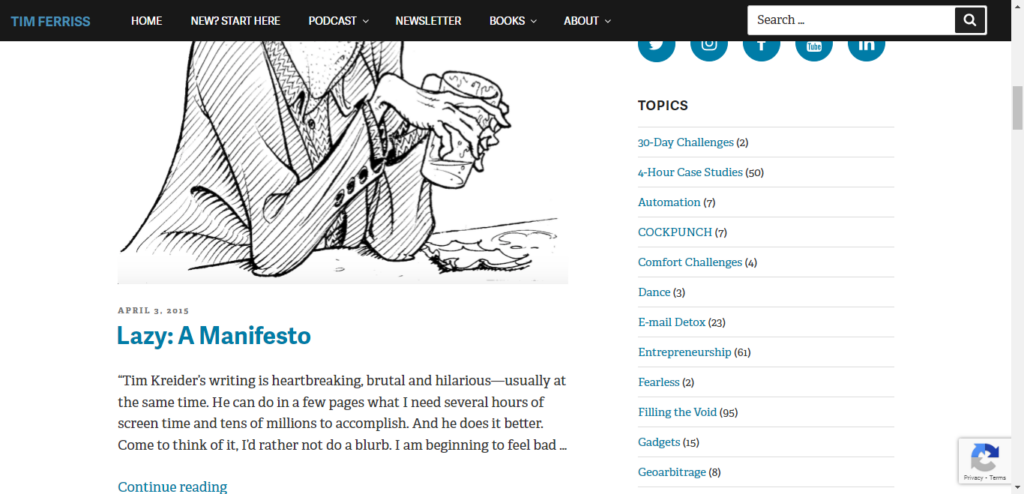
Out of thousands of books that he has read, he curates a list of content that made a meaningful difference in his life.
That kind of selective curation means a lot coming from someone with his reputation. Every entrepreneur will want to read these books.
Your own curation doesn’t have to be quite that strict.
Here’s another good example: James Clear’s book list.
He’s included more than 100 great books, sorted by category:

Now we’re getting into some advanced curation: not only picking out the best resources but organizing them in a most useful way to the reader.
Finally, this type of curation can extend to online courses.
For example, online computer science classes are offered free by hundreds of sites. Some are obviously better than others.
This post puts together the 16 best ones in the author’s opinion.
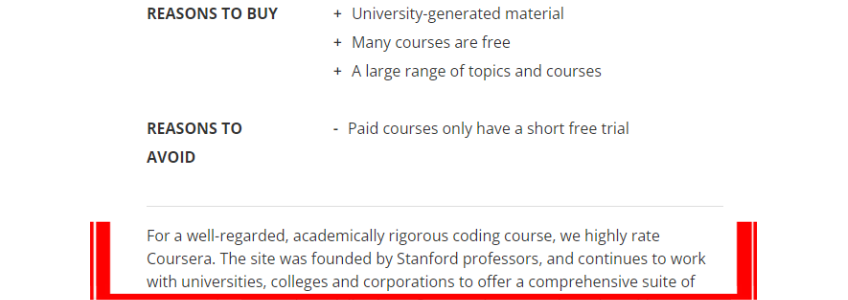
The key thing that makes this post valuable to readers is that it’s clear that the author spent time testing and reviewing each course.
Type #6 – Customer stories: Influencers aren’t the only ones who can create content. So can customers and readers.
Although you can only really do this if you have a large or raving fan base, one option is to curate the best customer reviews:
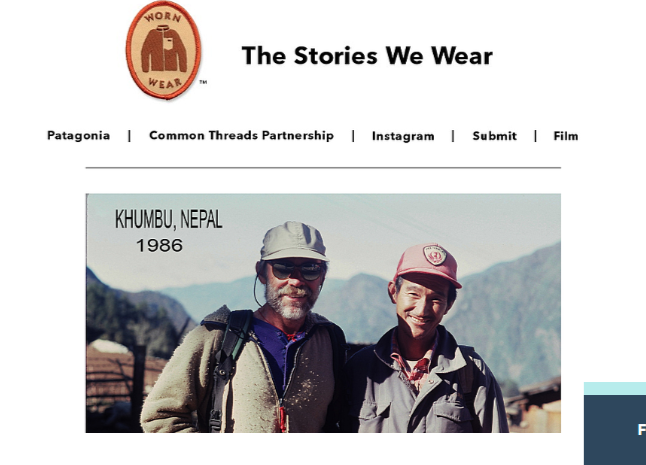
It’s easier than ever for bigger brands to do this now since many customers post pictures of themselves using the product on social media without even being asked.
You can find and save the best if you monitor your hashtags.
Type #7 – Top sites/experts: If you’re looking to build relationships with influencers in your niche, you can also create a top list of all the best sites or experts in it.

This is not as effective as it used to be because it is by far the most used form of content curation.
It can still be useful, but the main reason you should be doing it is to reach out to the people you include and open a dialogue.
Step 2: Understand the finer details of curation that make the difference
Many website owners post curated content on a daily basis.
The vast majority of it doesn’t get much attention.
We don’t want yours to be part of that.
In order to make sure that doesn’t happen, you need to understand the true value of content curation:
Quality.
If people just wanted to learn about a subject they like, they could head to an aggregator such as Alltop:
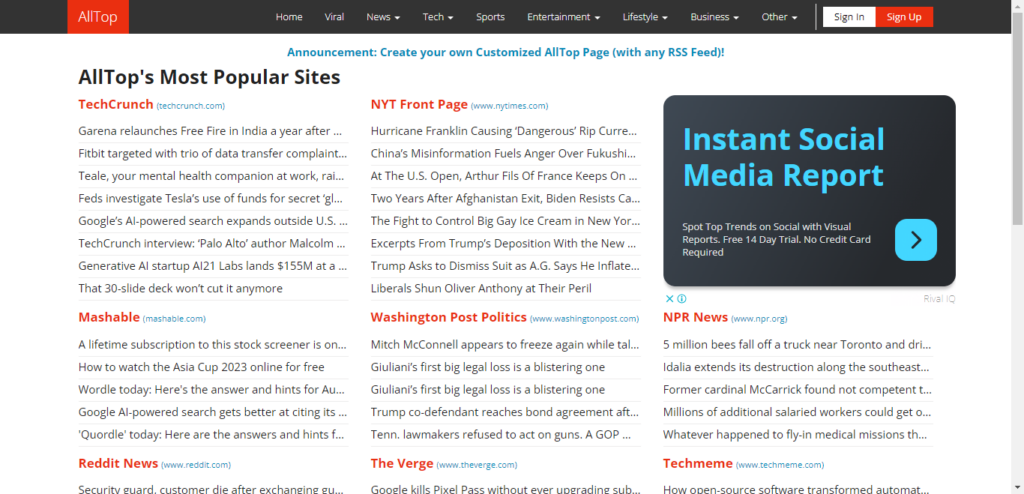
Just about anyone can submit content there, and it is categorized.
But people are getting overwhelmed by the amount of content out there. Although they don’t want to miss out on the truly useful content, it’s hard to wade through 20-30 pieces of content to find one or two good ones.
That’s where you come in.
You care about your audience and are willing to work hard for them.
Don’t get lazy: You must do two essential things to curate content properly.
First, you need to find all the content that fits your topic.
When you say you’ve assembled the best content out there, and ensure you didn’t miss anything.
As soon as you miss one great resource, readers will doubt you were as thorough as you claimed.
Second, you need to review all the content.
And we’re not talking about skimming the content. Do you think a movie critic skips through a movie to review it?
Never. You shouldn’t either.
It might seem like hard work, and it is. This is the main source of value for your curated content.
If you don’t thoroughly review every piece of content you’re considering, your final result won’t be as valuable to your reader.
Those are two simple but absolutely crucial steps if you want to see results.
Step 3: How to find perfect topics for content curation
The beauty of curated content is that you can really use it for any good content idea that you had in the first place.
However, you’ll still want to quickly run through this 3-step process for picking good ideas.
First, pick a type of curated content: We spent so much time on the different types of curated content because you should know which ones your readers value the most.
If you’re in a niche like marketing, you have a lot of options:
- ultimate guides
- roundups
- webinars
- case studies
- reading lists
- top experts
You can use any type effectively.
However, if you’re in a niche like camping, there aren’t webinars or case studies.
In that niche, readers value informative guides and video tutorials, so you’d want to stick to those types of content.
Second, define your scope: The scope of a piece of content refers to how large of a topic you will tackle.
The term is mainly used in descriptions of academic papers and studies.
But it’s important to pick a scope matching your content type.
When you create your own content, you can focus on a narrow scope and cover it deeply.
But when you’re curating content, you need to capitalize on the fact that you don’t need to create the content.
This allows you to go deep on a topic and wide.
Think back to Backlinko’s link-building guide. Here are the first three chapter titles:
- Link Building Fundamentals
- How to Get Top-Notch Links Using Content Marketing
- How to Execute Effective Email Outreach Campaigns
Each of those sounds like a huge post that we might write.
That’s why Brian links to at least three to four amazing resources in each chapter.
When you’re curating content, choose a large scope.
Brian didn’t just curate a guide to getting links with content marketing—he created an ultimate guide to link-building.
Finally, find a unique angle: If you’re curating content on a topic, that means a lot of content has been produced on that topic.
But that also means you must find a way to add significant value to it if you want to stand out.
There are a few ways to do this:
- Go bigger – in some cases, more is better (e.g., case studies)
- Increase your scope – cover a large topic that everyone else is too scared to do (e.g., ultimate guide to link-building)
- Go after a unique aspect – if many people have curated a topic, you can stand out by modifying it for a more specific audience (e.g., instead of Top X marketing blogs, do Top X marketing blogs for SAAS startups)
Step 4: 4 tools to track down amazing content and work more efficiently
Once you’ve picked the type of content you will create and the topic, you need to do the actual curating.
First, find absolutely everything there is to know about the topic you selected. Then, read/watch it, and save the best pieces.
There’s no wrong way to do this, but we recommend using a combination of tools to save time in discovering content.
1. Feedly: This is the leading insight-tracking platform. It curates the top sites in your niche and then shows you recently published articles so you can quickly see what interests you.
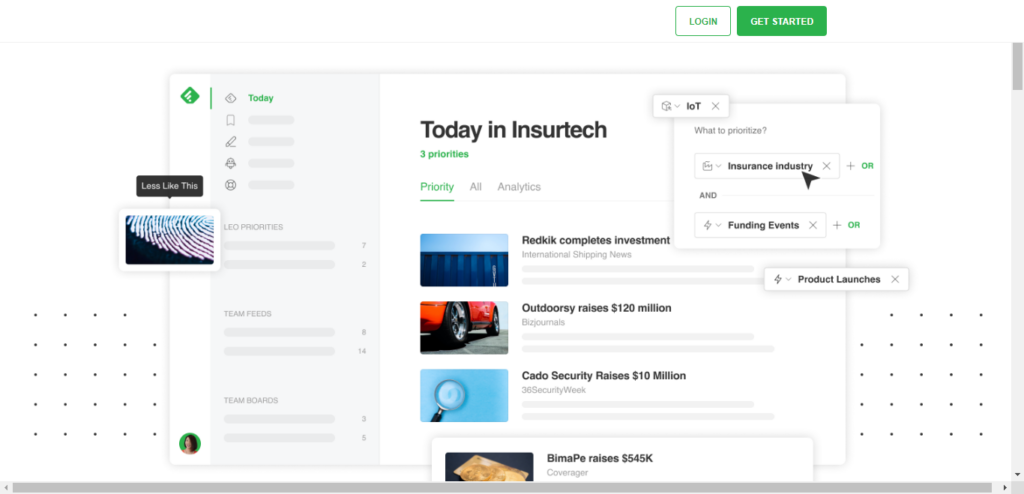
Add all the major blogs in your niche, and you’ll never miss a post.
2. Reddit: Reddit is one of the largest community websites in the world. It is broken down into subreddits, which are essentially different categories.
You can find a category for just about any niche, no matter which one you’re in.
After you find a relevant subreddit, you can visit it occasionally to see current trending posts. These posts are semi-curated by the community since they vote on them.
In addition, you can also click on top along the top menu of any subreddit to see the most liked posts of all time:
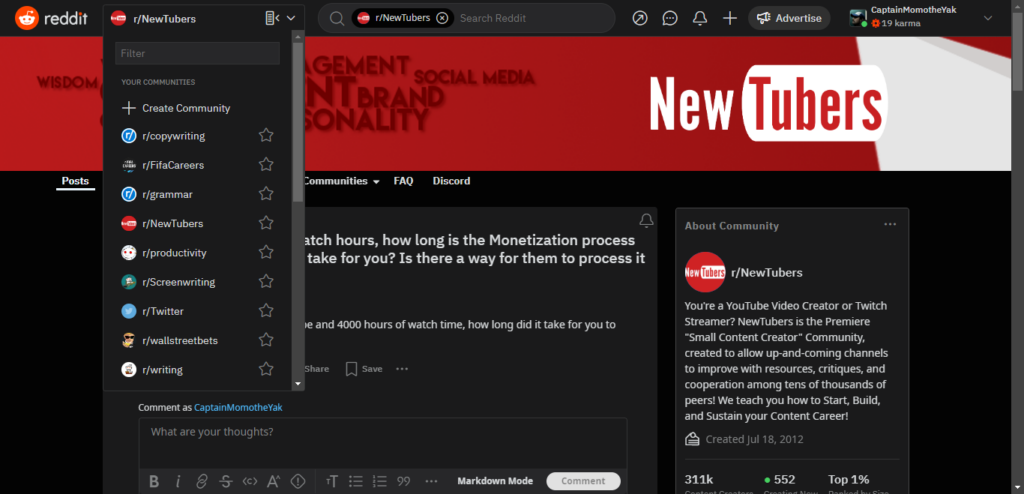
3. Evernote: Evernote is an extremely popular app that will help you stay organized and is free.
It’s essentially your own personal notebook that syncs across all your devices.
When you come across an article that you think is amazing, you can add it to your notebook and add tags and comments to it.

When it’s time to create content, just search for a few related phrases to bring up past content you’ve saved.
4. Trello: If you have a specific topic in mind already, your main challenge will be organizing all the content.
One option is to manage it with Trello, saving you much time.
Trello allows you to create boards and then add lists to them.
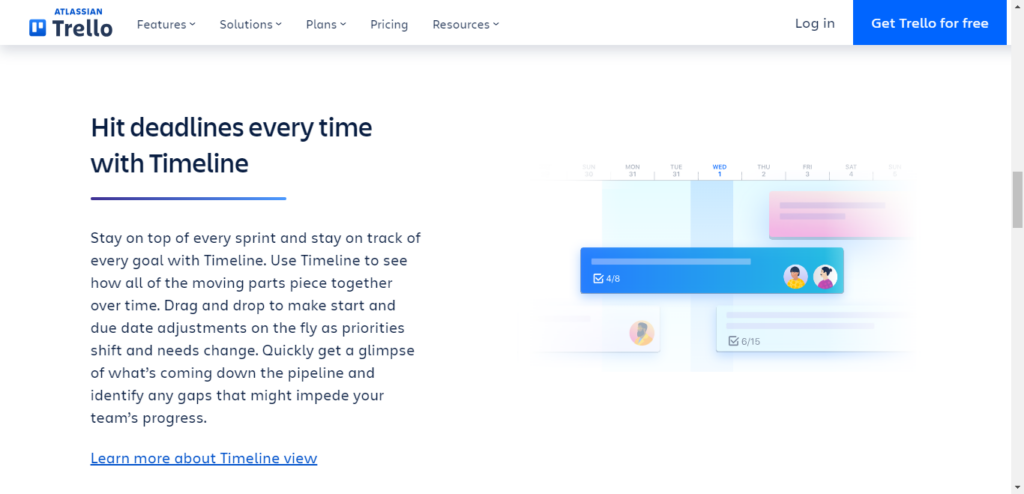
Put the headline as the title for each card, and click the card after you make it.
Step 5: Don’t just slap it together, do this instead…
Doing all the research for your content will take a ton of time.
It will be tempting to just publish your results in the easiest way possible; after all, the value is still there.
But if you do, you’re throwing away a huge chunk of your potential results.
There are two types of people in your audience that will read these types of posts.
First, your target audience. These are your typical readers that you created the post for.
When they come across a curated post, they have one main question:
Should we trust that these resources are actually the best?
If the reader doesn’t believe that your list of the best books on X is a good list, they won’t give it a second thought.
How do you gain that trust? Two ways:
- Be so well known that all readers know you as an expert (e.g., Tim Ferriss, James Clear)
- Present your content so professionally that readers assume you must know what you’re doing (partly the halo effect)
Secondly, if you’re covering a wide scope (like you should be), you’re going to be curating several (or hundreds) of other pieces of content.
Organization is key.
Most readers will only be interested in specific parts, so make sure it’s easy for them to find those parts. Create a custom table of contents or filters that readers can use.
The other part of your readers: Other than your regular readers, you also have all those people whom you featured in your content.
When you curate content, it means that you think that content is the best of the best, which is flattering to those content creators.
Most will check out your content when you send them a message about it.
When they do, they’re going to look at just a few key things:
- Does it look professional?
- How are we featured?
- Who else is included?
If it doesn’t look professional, it’s all of a sudden a lot less flattering. They’ll see you as a nobody who probably doesn’t have an audience.
They also care about how they’re featured. If they’re named as an expert, with a picture or glowing recommendation surrounding your link to them, you get a few bonus points here. They’ll feel more special.
Finally, they care about other included people. If they think that other pieces of content you’ve included suck, they’ll be disappointed.
When they see that you put in the time to include only the best, being featured is going to be a big compliment to them. If you just picked the first few resources Google showed you, it’s not impressive.
Conclusion
Curating content is a great way to save time while also creating high-value content that your readers will love.
It can attract shares and traffic and is a great way to open a dialogue with influencers you’d like to connect with.
Follow the five steps in this post, and you’ll have a killer curated piece of content to show the world.
